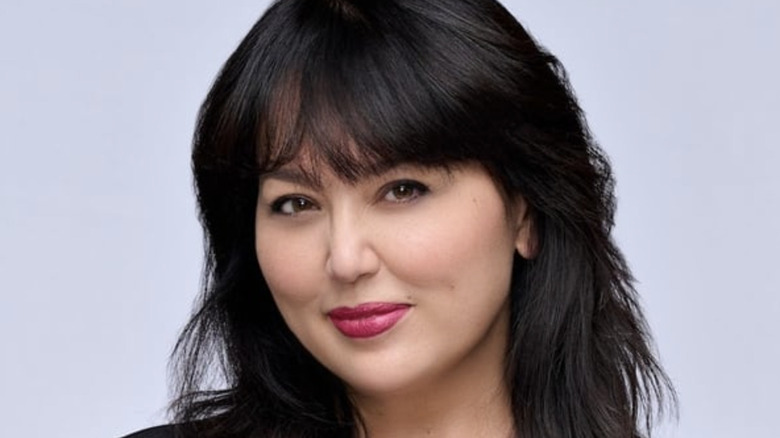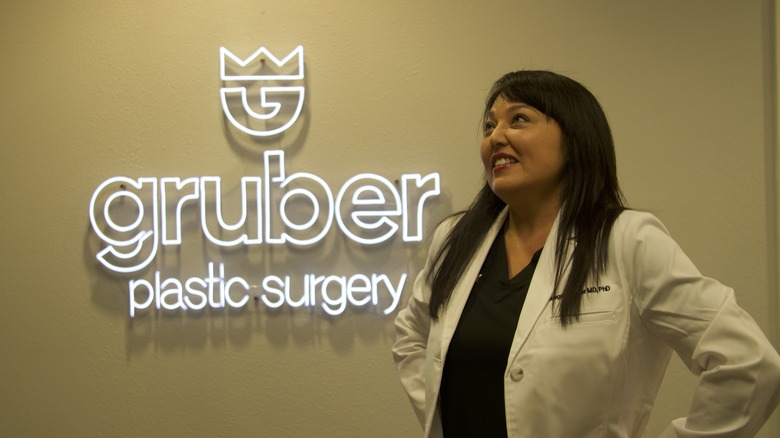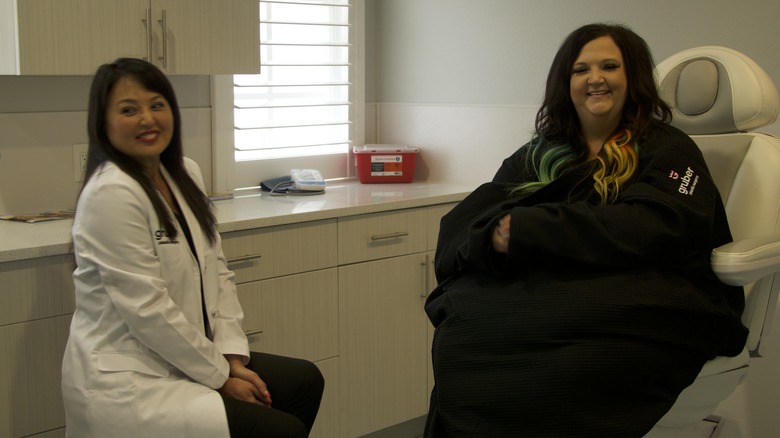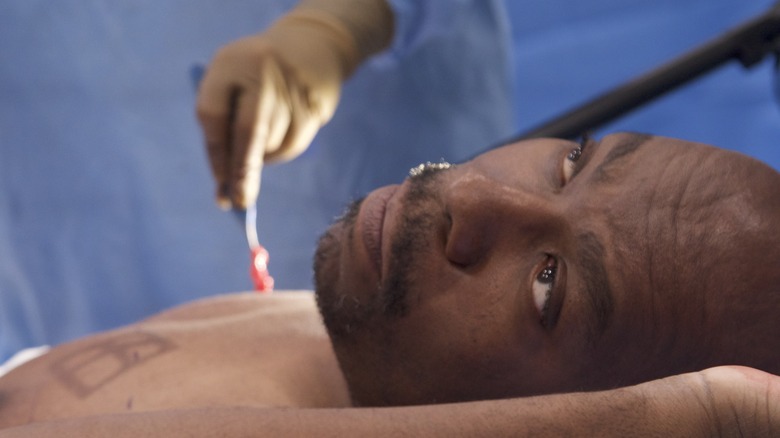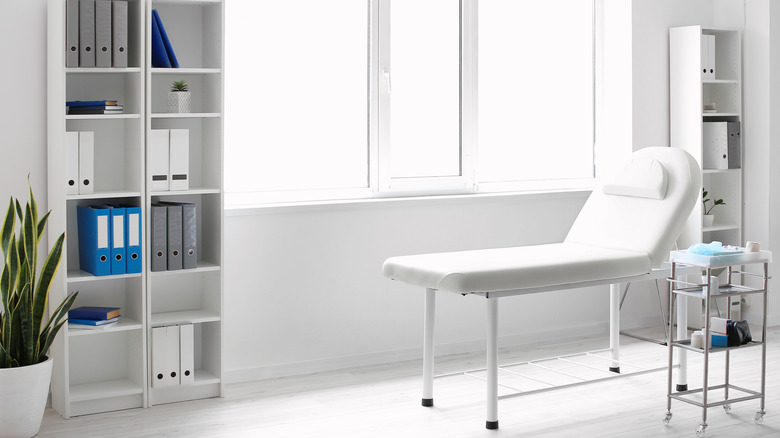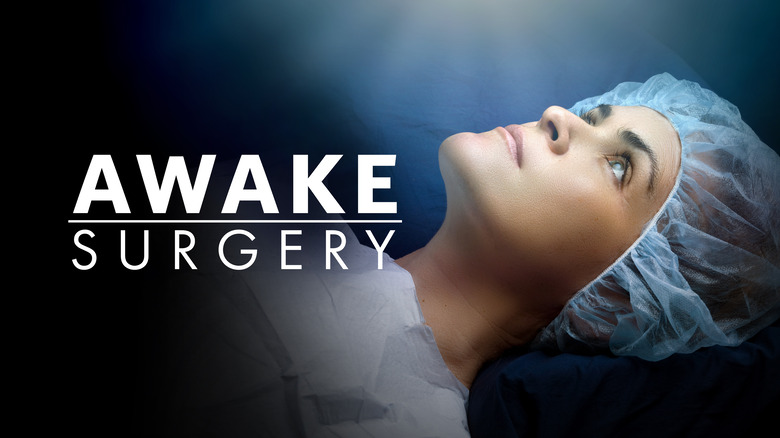TLC's Awake Surgery's Dr. Meegan Gruber On Why She Does Awake Surgical Procedures - Exclusive Interview
When you go to the dentist for cavity work or tooth extractions, you'll get local anesthesia to numb the area. As your dentist works inside your mouth, you might feel some pressure or pulling that might make you a little nervous. Now imagine being awake during a tummy tuck — the doctor performs the surgery while you're awake so you can see the results immediately. That's how board-certified plastic surgeon Dr. Meegan Gruber operates. Because she knows many patients who fear going to sleep during surgery, she offers patients the option of "awake" surgical procedures.
Her signature awake procedures will be featured in her new show, "Awake Surgery," on TLC. In an exclusive interview with Health Digest, Dr. Gruber told us how she moved from traditional surgery to awake procedures and why her patients choose them. She also advised anyone thinking about cosmetic surgery to find a board-certified plastic surgeon to avoid complications.
Gruber's move toward awake surgery
Your show and your practice are called "Awake Surgery" based on your own techniques for performing surgery without general anesthesia. Why did you move from traditional surgery to awake surgery?
At the beginning when I first finished training, I worked only in the hospital, and I only worked with anesthesiologists. It was not sedation. It was not partially asleep. It was fully asleep patients, and most of my patients were cancer patients and car accidents.
There was not even a thought to do surgery in my office at that time. I spent a decade doing that kind of surgery, which you think of in general when you think of surgery. Then the hospital system that I was working with decided to merge, and they said, "Okay, it's time for you to be private."
I decided to take a position as a cosmetic plastic surgeon. During that time, because of the way patients were asking for things, I learned to do more of the cosmetic techniques with the patients sedated. After working there for a little while, I joined someone who was not a plastic surgeon. That doctor could not operate in the hospital. He did not have credentials. Only surgeons can operate in hospitals with patients under anesthesia. The people that do [plastic surgery] with patients awake are non-surgeons, so they're muddling through a tummy tuck or breast implants. It's horrible. They're like, "I saw one on TV. Let me try that." They're not surgeons.
They're not surgeons?
Right, so when most people who know anything about awake surgery — and doctors, especially — think about it, they think about these dermatologists and internal medicine doctors, people who never trained in an operating room and aren't allowed to put people to sleep and do surgery on them.
They think of those doctors and go, "Why would anybody want that kind of surgery? That's gross. I want a real surgeon." Well, I'm a board-certified plastic surgeon. I have all the credentials. I used to only operate in operating rooms. I realized at some point, [awake surgery] is actually beneficial for the patient. Not going under anesthesia [and] being able to get up and move decreases the patient's risk of complications.
They're at a decreased risk for blood clots. Not going under anesthesia decreases their risk of pneumonia after surgery, because they don't have the tube down their throat. It decreases their risk of heart attack and stroke because the blood pressure fluctuations aren't there. Then, [for] anybody allergic to anesthesia, that's out.
The demand is for people who are afraid, or they saw somebody like Joan Rivers die from her tube being in the wrong place and she went out. That's scary, and people know that she died from anesthesia — not from it, but from lack of proper anesthesia. If she was fully awake having her surgery done, she wouldn't have died. Period.
Then there are the people where there's a need in terms of health. You have somebody who's lost a massive amount of weight — they're still at very high risk for a blood clot. Even after the weight loss, they're at very high risk for a blood clot. You add the five- or six-hour anesthesia on for their total body lift, and you're talking about a huge rate of blood clot risk, upwards of 5%, which is ridiculously high.
How awake surgery reduces patients' fears
What are some of the fears that your patients encounter when they come to you for help and they request awake surgery?
It could be as simple as they've had anesthesia before and they woke up feeling horrible. Some people have protracted fogginess of the brain, which is a mild thing, but they don't want to be groggy or foggy for a couple of weeks. There are other people who had protracted nausea and vomiting. Who wants to throw up for three days?
One person said that she woke up terrified, screaming, cussing. That does happen to some people. There are the people who have had relatives die, or they've seen people in the news that have died. There are people who, for some reason or another, [are terrified of] flying in an airplane or going up a ladder — they're just born that way. They don't want to go to sleep. Very rarely, there are people who have actual allergies and whatnot.
With patients who are at higher risk — maybe they had a blood clot before in pregnancy or maybe their uncle died of a blood clot — almost all of these patients have read for years about this surgery before they decide to have it. They know the risks are higher, especially with tummy tuck. Tummy tuck has a particularly high risk of a blood clot. The awake tummy tuck is requested quite a bit because people have read and they know that it's one of the higher risks for blood clots.
If your cousin died of a blood clot and you read, "Oh my God, if I have this surgery, it's a higher risk for a blood clot, but if I do it awake, it's not," then that's enough to push some people toward, "Let me do it awake." Then they see my results, and they see that they're as good, if not better.
Finally, what I'm seeing more now is, "I'm afraid of being botched," or "I've already been botched once." If they're awake during the surgery and I tell them, "You could get up and go to the bathroom. You could look in the mirror" halfway through, that is a confidence builder.
People want that control. "I was there; I saw what they were doing. Also, nobody's raping me." Isn't that a horrible thing? That's been in the news. It's really gross. Recently, two or three weeks ago, a doctor in Miami was sentenced for raping people under anesthesia ... Isn't that horrible?
But that gets all over the news and especially in the plastic surgery forums. One person starts talking about that. Who's going to want to let themselves go to sleep anymore? It's gross — it's a horrible thought.
I see this being a trend, and I want to take it out of the hands of non-surgeons. These surgeries should not be in the hands of non-surgeons, period. You shouldn't cut on somebody if you can't do it in a hospital, because God forbid anything happens. What are you going to do with that patient? You can't help them.
If you or anyone you know has been a victim of sexual assault, help is available. Visit the Rape, Abuse & Incest National Network website or contact RAINN's National Helpline at 1-800-656-HOPE (4673).
How Gruber keeps patients calm during awake surgery
Tell me about these unusual and special treatment methods and how you came up with them.
I basically took what we know already about what's safe with lidocaine. Technically, it's not no anesthesia; it's local anesthesia, like a dentist would do on your teeth. It's no sedation. Your consciousness, your ability to do math problems and talk, is not affected. It's just the local anesthesia.
Every surgeon — every plastic surgeon and other kinds of surgeon — knows how to do surgery with local [anesthesia]. We put stitches in, we do little things in the office. If somebody needs a mole removed, this and that, we can do it with numbing. You take that and you extrapolate out. We know from good scientific data that you can put in with liposuction 55 milligrams per kilogram of lidocaine, and the patient toxicity level is fine and people do well.
I took that formula, which has a certain concentration of lidocaine, which is very diluted, and I increased it a tiny bit, based on what that other doctor was doing. That's not a surgeon that was doing lipo. He was cowboying in lidocaine, and I was in shock. But I took what he was doing and, step-by-step, increased it a little bit. Up until today, I still don't go over 30 milligrams per kilogram — pretty much half of the legal limit, I use.
I learned how to make patients relax. We all know that when we go to the dentist, it doesn't feel great. There are some pinchy times; there are some pokey times; the gums bleed. It's not the greatest. But none of us come out of there crying and wailing. We all [go], "Okay. It's going to be over soon." I took that philosophy.
I also don't know where I got the idea to tap people, but it came from many different directions. My daughter had some anxiety, so I was looking into how these tapping methods decrease anxiety. Before you go up on stage, you're supposed to do this tap here. I decided to try that on patients. It's a miracle.
It's allowed me to go deeper and deeper into doing ... Now I can do circumferential body lifts, where you cut all the way around. It's crazy. It's because patients are relaxed. When you're relaxed, you don't need as much numbing medicine. Your nerves aren't on edge; it feels like pressure, not necessarily pain.
I went there with these relaxation techniques. We try to keep the patient busy and play music they know the words to. All these different little techniques were added on and on. Every time I realized I could do a little bit more, I do a little bit more ... So not increasing the toxic numbing medicine at all, I was able to increase the complexity, the length, [and] the depths of my surgeries, by adding on these Zen relaxation techniques.
Awake surgery offers shorter recovery
Describe the recovery process that's different from awake surgery versus when they go under general anesthesia.
There are two surgeries that I do exactly the same under anesthesia or awake: breast lifts and arm lifts. [With] tummy tucks, I sometimes do them the same without the muscle tightening, so there are three different things. Across the board, the people who get their tuck awake, walk out, and walk back in the next day for their follow-up are back to work in four days, and they say they have very little pain — hardly feel it at all. I, for the life of me, do not know why they have no pain and the patients who I do under anesthesia come out and they're doubled over and they feel horrible for at least a week. They don't go back to work for almost two weeks. I can't explain it. I have some ideas that it may be because I can't go fast and vigorously when they're awake.
I have to go precise and slow, so I can't be banging into their muscles. I can't be banging into their skin. The only layer that's numb is the fat layer — it's muscle, fat, skin. [There's] no other way — I have to stay very true to that layer, which doesn't have a lot of nerves. I also have very little bruising, almost none, because I don't hit those areas of blood vessels. I have to stay very contained.
Maybe because of the numbing fluid — I have to make sure it's really well perfused and that I'm not giving them any feedback into their nerves at all. We know that even when patients are under anesthesia and their brain is asleep, when you do surgery on them, their nerves are firing, their sensory nerves. Lots of anesthesiologists encourage you to put the local in even though the patients are asleep. But most surgeons don't. They're like, "That's dumb. Why am I doing that? They can't feel it." Maybe it's that.
Finally, the thought is, now they're giving people glucose right before surgery, because that stress that their body's under depletes the sugar over time. It's a stress response to fight or flight. I carbo-load my patients the day before, and I give them Gatorade in between the breaks. To me, it's like if you try to run a marathon without fueling and refueling. How good would you feel in a week? Horrible. But if you fueled and refueled, you'd probably bounce back in several days.
That might be what's going on. It's all speculation, but to me, it makes sense. Why are all of a sudden people injecting numbing medicine into asleep patients and trying to give them sugar? It kind of goes with it.
Awake surgery success stories
Tell me about some of the people your audience will meet in "Awake Surgery."
I had a patient — one of the most amazing ones — who had an incredibly odd growth of her saddle bag. The rest of her was a regular proportion, not overweight, young, healthy mom. She, with each pregnancy, started getting these larger and larger saddle bags such that each one literally was big like a honeydew. It was bigger than a cantaloupe and smaller than a watermelon. It was like a honeydew on each side of her hips, which was double the width of her natural hips.
It made her twice as wide as she had to be. That was incredible and more difficult than I thought it would be, mostly because she had never had any surgery before, not even a C-section. She was petrified of the knife. But once she realized it didn't hurt and all that, she got through it good.
I had a patient with massive weight loss who had gone up around 400 pounds, and she lost 150 of it, but she was still large. The problem was she couldn't get down any lower because she could hardly move. Her abdominal flap reached below her knees. Walking, she had to kick her body forward. She couldn't raise her leg without kicking that flap of abdomen skin forward.
Doing her, I had to break it down into steps. I was so concerned that I wasn't going to be able to get her through all those things — it's so much. But we did it, and she healed better than I've ever seen somebody of her size heal. Two weeks, and her wound was pristine. Usually, these big patients will have openings, and they'll ooze and have wound problems. She's done great.
A gentleman who underwent a different kind of surgery [said] right before he fell asleep, the doctor told him, "I'll see you on the other side." He never forgot that, so he said he told himself he's never going under anesthesia again unless he's dying. He had the man boob syndrome where he was embarrassed. He couldn't wear a T-shirt and stuff like that, so that was rewarding for him.
Those are the basic big ones. I'm hoping this will not just wow people, but allow anyone who feels like they're trapped in their body and held back by these issues that are safely solvable [to] understand that they don't have to put themselves in such medical danger. They don't have to put themselves under such emotional strain of having to overcome that fear of anesthesia.
You can catch Dr. Meegan Gruber on her show, "Awake Surgery," on TLC starting December 14 at 10 p.m. ET.
This interview has been edited for clarity.

